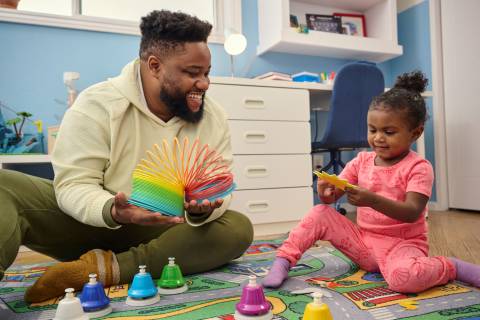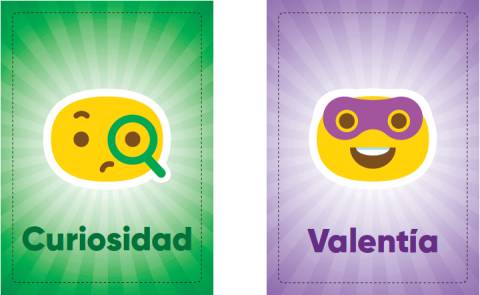Play is a powerful way to help children learn, grow, and bond with you and their peers. If you’re a caregiver to children with special needs, there are several ways to adapt activities to create a fun learning environment where they can build their confidence and their skills.

When children with special needs engage in activities designed for their abilities, they gain a sense of accomplishment, build self-confidence, and develop a more positive self-image. These experiences also help them develop essential life skills, improve their communication, and increase their independence, positively impacting their overall well-being. Playing together also helps build the parent-child bond and create lasting memories together.
We’ve provided some activities you can try out with your child, as well as some ideas for customizing the activity to better suit their needs. These activities focus on engaging their senses and building important skills in a fun, safe environment.
Music and dance are forms of expression that can be adapted to suit the abilities and preferences of children with special needs. Engaging in music and movement activities can support physical coordination, balance, emotional expression, communication, and social connections.
Adapting music and movement activities for children with special needs involves adjusting the structure, equipment, or speed of the movement to create an engaging experience. Here are several examples of how parents can adapt music and movement for children with different special needs.
Visual impairment:
Tactile instruments: Provide instruments with textured materials, such as shakers with raised patterns, to help children identify what the instrument is and grip it more easily.
Guided movement: Offer a gentle guiding hand or use verbal descriptions to direct movement and position during dance activities or games.
Descriptive language: Use clear, descriptive language when teaching new dance moves or actions, allowing the child to visualize the movements.
Hearing impairment:
Visual cues: Use big movements, sign language, or visual aids like flashcards to help children catch the rhythm or lyrics of a song. There are also music videos online that include various visual cues in coordination with the music.
Vibrating instruments: Introduce instruments that produce strong vibrations, such as drums, to allow children to feel the rhythm and flow of the music through touch.
Use a microphone: When possible, use a microphone to amplify your voice during singing or dancing activities so children with hearing aids can better engage in the activity.
Mobility challenges or wheelchair use:
Adapted dance moves: Modify dance moves to be performed while seated in a chair or wheelchair, focusing on upper body movements or rhythmic tapping of wheelchair wheels to the beat of the music.
Accessible instruments: Provide adaptive musical instruments, such as modified drumsticks, Velcro-secured shakers, or push-button electronic instruments, to make the instruments easier to use for all children.
Developmental or cognitive disabilities:
Simplified routines: Break down complex dance steps or rhythms into smaller, more manageable series, and provide clear instruction and visual cues, if necessary.
Steady pace: Maintain a slower, steadier pace during music or dance activities, allowing extra time for processing and understanding.
Sensory sensitivities:
Volume control: Lower the volume of music or use headphones with volume limits to meet the needs of children who are sensitive to loud sounds.
Choose calming music: Opt for soothing or calming music genres and simple rhythms to reduce sensory overload, and engage children in a gentle, relaxing experience. Nature sounds with some light instrumentals can be a good genre to try out.
Action games can help children develop social skills, such as turn-taking, cooperation, and following instructions. They can enhance concentration and motor control. By accommodating various abilities within these games, children with special needs can have fun with their peers and gain confidence in their abilities.
Visual impairment:
Tactile markers: Use textured materials, such as rubber mats or foam, to mark boundaries or to provide guidance for navigation in games like “Follow the Leader” or “Obstacle Course.”
Auditory cues: Incorporate sound-emitting objects, like bells or toys that make noise, to guide players or signal specific locations in games like “Hide-and-Seek.”
Hearing impairment:
Visual cues: Use visual aids like colored flags, gestures, or sign language to communicate instructions, and indicate a player's turn during games like “Simon Says” or “Duck, Duck, Goose.”
Vibrating toys or wearable devices: Try incorporating vibrating toys or devices to signal a player's turn or notify them of a change in direction or activity during games like “Musical Chairs.”
Mobility challenges or wheelchair use:
Adapted rules: Modify the rules of games like “Tag” by designating a specific body part to be touched or implementing a two-hand touch rule, which can accommodate children with limited mobility or those who use wheelchairs.
Adjusted game setup: Create wider playing areas or adapt rules to be navigable by wheelchair users. For example, in “Simon Says”, make a rule that Simon can only move body parts from the belly button up. If you’re doing a treasure hunt, select a flat, obstacle-free space and place clues at a height accessible to wheelchair users.
Developmental or cognitive disabilities:
Simplified instructions: Break down game rules into smaller, manageable steps, offering clear, concise instructions, and create visual cues if necessary. This can be particularly helpful in games like “Red Light, Green Light” or “Simon Says.”
Extended time limits: Allow more time to complete tasks or accommodate various processing speeds during games like “Statues” or “Freeze Dance.”
Teamwork and support: Pair players with varying abilities and encourage teamwork to complete games like relay races or scavenger hunts.








